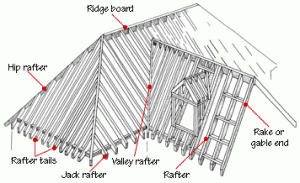Framing Between Two Peaks On A Roof
Position the square at the end of the rafter board with the tongue on your left and facing away from you.
Framing between two peaks on a roof. This beam will provide the backbone for the cricket or saddle. Unit run of the hip. Draw a diagonal line between 9 feet the run of the main roof on the tongue of the square and 7 feet 6 inches the secondary roof run on the blade. Explore framing complexities that result when roofs of two different pitches intersect.
2x8 sleepers should be nailed to the roof surface to pick up the ends of the rafters. At the low end of the valley the subfascias of the two roofs are mitered with a block filling in the roof framing. Measure form the top of this line down the board to determine the line length or length of the rafter less the ridge. Essentially the spine of a conventional stick framed roof the ridge board is sandwiched between the meeting ends of the roof rafters.
Learn more about off angle roof framing. The ridge is the horizontal peak of the roof. The ridge is the peak where two sloped roof sections meet. In a standard gable roof the ridge.
Roof pitch refers to the amount of rise a roof has compared to the horizontal measurement of the roof called the run. The ridge board is the horizontal framing member that defines the roofline in a gable roof. Line the gable studs on top of the house studs and leave room for a sheathing layer. This gives the angle of the hip rafter.
Once the ridge beam is solidly supported it can continue to where it intersects on the house roof surface. Sheathing blocking is added along the valley and the sheathing pieced in for both roof planes. Add the length of the overhang beyond this mark and. To transition the eaves the horizontal fascia extends to the last rafter tail and a vertical return finishes the transition.
It extends from one gable end to the other at the peak of the roof. In a hip roof with equal pitches the unit run of a hip or valley rafter is 17 inches for every 12 inches of run in the main roof.















































